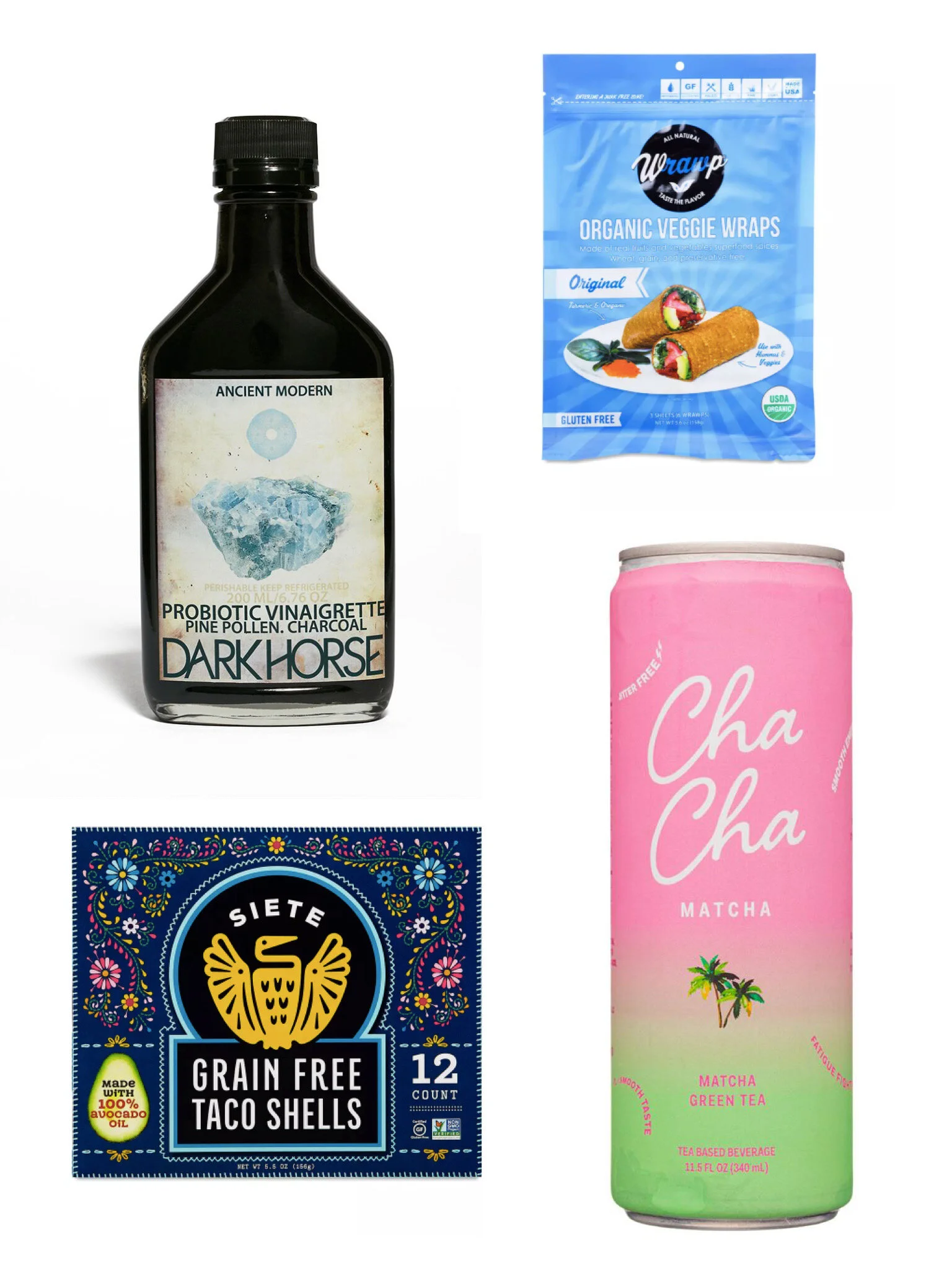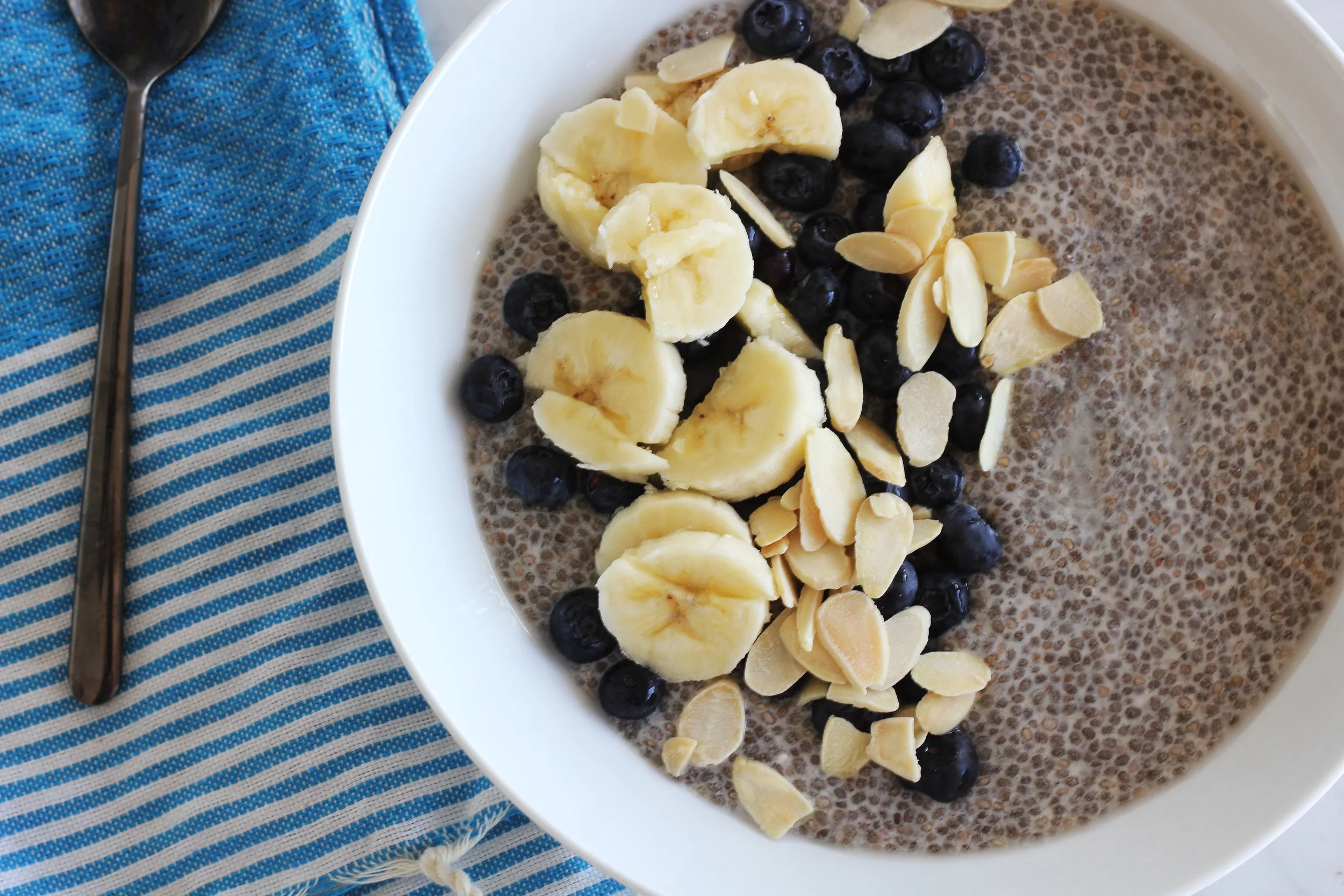If you love these cassava pancakes, the addition of 1-2 tablespoons of cacao makes them even better.
LB'S MATCHA BEAUTY TONIC
Spring in quarantine is the perfect time to establish (or re-establish) a self-care routine. Self-care doesn’t have to mean a luxurious day at the spa or come with a heavy price tag. It can be super simple. For example, I've been enjoying this Matcha Beauty Tonic every morning with my phone and computer turned off.
I love matcha. It provides a delicious nutrient-rich energy boost pre and post -Studio LB. And it has so many amazing benefits. It gives you the zip of coffee without raising your heart rate. It also keeps you satiated and works as a fat blocker by blocking the ability of digestive enzymes to break down fat, a step necessary for fat to enter our cells. So instead of absorbing and storing the fat, it gets passed through the body. Matcha is also rich in chlorophyll, which alkalizes and detoxifes the blood. By increasing its pH, the body has a better chance of getting more oxygen and nutrients to cells for healing. I notice that my skin looks more radiant and I feel revitalized when I drink it.
Spring Matcha Beauty Tonic
Ingredients
1/2 tsp. matcha
Choice of nut or oat milk to taste
1/4 tsp. ashwagandha (adaptogen/stress relief)
1/4 tsp. reishi (superfood/immune booster)
1/4 tsp. mesquite (superfood/blood sugar stabilizer and protein)
Directions
Scoop matcha powder (start at 1/4 tsp. then adjust according to your taste), ashwagandha, reishi, and mesquite into a cup. Fill cup with hot water, and then whisk in your choice of milk until it starts to froth.
GO WITH YOUR FLOW
Image courtesy of JessTales on Etsy
Early this week I was having trouble springing out of bed and just felt aggressive and in a funk for no real reason. Now, I’m no rookie as this happens every month but yet I still don’t realize that it’s my cycle that’s making me feel like a total lunatic. When I looked at the calendar it made so much sense. No, not Daylight Savings Time, the full moon, or Friday the 13th… but my period was set to start at any moment. I’m trying lately to be more aware of my cycle, and adjusting to meet my hormonal and mood shifts throughout the month.
Each menstrual cycle starts on the first day of your period, and ends when your next period begins. In that time you have a menstrual phase (period), follicular phase, ovulatory phase, and luteal phase. Your menstrual phase is actually a part of the follicular phase. Five major hormones are at play during your cycle and rise and fall over the course of the month: estrogen, testosterone, follicle-stimulating hormone (FSH), luteinizing hormone (LH) and progesterone. What you eat and the intensity of your movements can help optimize your energy as these hormones shift throughout your cycle.
While I’ve always listened to my body when it comes to how hard to push exercise, lately I’ve started shifting the foods I’m eating to match my cycle too. During your menstrual phase, estrogen and progesterone start low and then rise over the course of the follicular phase. Estrogen peaks during ovulation with testosterone and progesterone rising, and then if an egg isn’t fertilized the hormones start to decrease before the next cycle begins. Everyone has a slightly different timeline for this cycle, but it averages around a month.
I’ve found my energy maxes out during ovulation, and then falls right before my period begins. My surge in energy during ovulation would make sense with testosterone peaking so this is when I add my pre-Activation canyon hill runs into the mix on top of filming Studio LB workouts. This is where I (and you) can really push it with heavier weights, higher intensity and getting in every single rep since hormones are on your side! Leading up to and during my period, I focus more on stretching, yoga, and flow workouts to match my lower energy level.
As for food, you all know that my staples are rich in leafy greens, lean proteins and complex carbs. These foods make me feel good no matter where my hormones are at but I’ve started peppering in a few other ingredients to match my cycle. Directly after my period and during the remainder of the follicular phase before ovulation, I’ve learned that fermented foods can help metabolize estrogen. Adding kimchi, kefir, miso into the mix seem to help even me out during these weeks.
Then, just before my period during the luteal phase it’s normal to crave foods heavy on the salt and fat as we find them comforting. But some other serotonin boosting foods are said to be eggs, pineapple, and salmon. I’ve found cooking these up during PMS times helps curb the cravings for salty mac and cheese or some of Mars’s In-N-Out fries.
Finally, during my period I’m prone to iron deficiency (as are many women), so I add spinach to basically everything from salads to soups to eggs to smoothies. While I’m not a huge meat eater, during my period is generally the only time a filet mignon seems super appealing too.
I know that you guys also feel the push and pull on your appetite and energy levels throughout your cycle. I’d love to know any resources or books to look for to learn more too! Let me know on the hotline 424-327-5470
HOLIDAY FRIDGE MAKEOVER TIPS
During the holidays my fridge gets out of control really quickly. And when it does, I totally lose track of what I have in there. I also lose a little inspiration to eat healthy which makes me feel great and keeps my energy levels high. This week is the perfect time to tackle your refrigerator and give it a good makeover pre-holiday. You'll feel better, and it will inspire you to eat healthier too.
Clean House. Get rid of limp veggies and check expiration dates on all of your condiments.
Prep! Take fruit and veggies out of plastic bags and cut them up so that they are ready. Arrange salads and vegetables so you can clearly identify what you have on-hand.
Clear Containers . We tend to use what we see. I like to cut up melon, pineapple, and berries and store them in these. Because glass containers are expensive, I hesitated for years but most of my vegetables and salad greens are neatly displayed in them now. In addition to being freezer, microwave and dishwasher-safe, the thick tempered glass makes them quite durable and chip-resistant, and I love the fact that you can clearly see the container's contents. When not in use, the containers and lids nest perfectly inside each other, and when they are in use, the square containers fit neatly side by side, maximizing precious fridge/freezer space.
Fresh Herbs. Fresh herbs add so much flavor to salads, soups, smoothies, and are believed to be more beneficial when enjoyed fresh rather than dry. Each week I try to invest in a few different varieties and store them in pretty glasses in my fridge or by my sink. Right now I’m enjoying lemon balm and mint.
Leftovers Up Font. In the past, leftovers quickly got lost in the back of my refrigerator. Now, I make an effort to keep them in the front (in my glass containers) where my family can see them. I really get creative with my leftovers - I like to double the recipe for quinoa salad with carrots, parsley, and basil and toss it with a baby spinach, make a quinoa frittata, or tuck it into a wrap.
Spa Water. Water keeps your body hydrated, your skin glowing, and revs up your metabolism.
Organize Condiments. All the different varieties of dressing, mustard, tamari, vitamins and hot sauce were exploding out of my fridge. So, I took a hard look at what I had and considered whether I really used it and enjoyed it. If not, I tossed it.
Healthy Swaps
With the holidays come delicious but super decadent treats. Indulge in them all and you"ll feel (and look) bloated, skip them all and you'll feel cheated. I prefer to swap many of them for their lighter cousins. (Think: No to that second calorie and sugar-laden coffee, yes to to Cha Cha Matcha).
Here are a few ideas for picking healthier foods this season.
Cha Cha Matcha
Swap your second sugary coffee with Cha Cha Matcha. It’s Antioxidant rich, has a great taste and a clean buzz with zero calories, zero fat, and zero sugar.
Dark Horse Probiotic Vinaigrette
I make my own dressing but Dark Horse Probiotic Vinaigrette is SO good and always in my fridge. Made with ingredients like sauerkraut liquid, pine pollen and charcoal - it’s effervescent and delish.
Wrawp Veggie Wraps
Collards are my go-to but I keep Wrawp Veggie wraps in the house for when someone wants more heft without the bread. They make great quesadillas, pizza and panini’s, as well.
Siete Foods Grain-Free Taco Shells
So good - just an all around better option. Siete Foods taco shells are made with cassava flour, avocado oil and are only 120 calories for two shells.
SEPTEMBER TASTEBUDS
Summertime, Labor Day, juicy tomatoes, and watermelon salads are just about in our rear view mirror, and it’s all Pumpkin Spice lattes (and candles, and laundry detergent wtf) as far as the eye can see. The cooler temperatures and back to school vibe are affecting my cravings for different ingredients, and I love to turn to what’s seasonal. Here are a few great foods to toss into your fall salads and weeknight dinners this month to embrace autumn’s arrival.
Figs
In August and September, it’s all about figs. If you’re not using them in your salads, baked goods, and breakfasts you’re seriously missing out. Figs are antioxidant rich, high in calcium and iron, and super high in fiber. I recently discovered grilling figs to add to salads and it’s a great blend of sweet and smoky.
Prickly Pear
This funky cactus ingredient is said to counteract inflammation and act as a hangover cure… sign me up. It’s high in fiber and carotenoids. These guys are all over my hood but you can often find prickly pear (or cactus pear) at farmers markets or natural food markets, and it’s great peeled and raw or added to smoothies for added natural sweetness. Remember to wear gloves as you slice and peel them to not end up with spines in your fingers!
Butternut Squash
Roasted squash has to be the heartiest, most delicious, smoothest ingredient I look forward to the minute the temperature drops below 70 degrees. It’s the simplest way to make any greens into a meal, with or without additional proteins. Eating antioxidant rich foods, like squash, has been said to aid memory recall and preserve mental acuity as we age so I’m keeping this half-sweet half-savory nutrient dense squash in my regular rotation this fall.
Sunchokes
In North America, sunchoke season begins technically in October so I’m prepping myself in anticipation of these tubers. They’re high in potassium, iron, and protein and they’re known to aid blood pressure regulation. They’re slightly nutty and a little sweet, and are great sliced thin and added to salads, baked, or sautéed and made into soups. Remember when we talked about prebiotics the other week? This is a good one!
Tell me what you’re cooking up this fall to stay warm but also keeping it high and tight! Sound off and share your favorite seasonal recipes in our facebook group too.
BUZZY INGREDIENTS
Image via IG @gabbois
I think we can all agree that more greens and fewer items that come from the middle, highly processed aisles of the grocery store are key to a healthier diet. I definitely subscribe to a KISS (keep it simple, stupid) approach with food, but I also am fascinated by the science of nutrition and alternative approaches and fun ingredients. Sometimes, technical food terms can get complex so I wanted to break down a few food-related buzzwords and my thoughts on each: probiotics, probiotics, adaptogens, and fermentation.
A prebiotic is an ingredient that our bodies cannot digest and stimulates growth of positive microorganisms inside. A probiotic is a live microorganism like bacteria similar to those in our body already that we ingest for healthy gut benefits. They have been shown to aid in digestion.
The use of prebiotics and probiotics together to benefit gut health is called microbiome therapy. You don’t need to ingest a prebiotic for probiotics to work, but eating them through foods or a doctor-approved dietary supplement might make your probiotics more effective. Prebiotics act as a food for probiotics, and they can be found in fiber-filled foods like fruits, vegetables and whole grains. Probiotics occur naturally in foods like yogurt, sauerkraut and tempeh. So far, there’s been less scientific research on the benefits of prebiotics than probiotics. A happy gut means a better immune system, better sleep, better mood, and overall positive health.
In herbal medicine, adaptogens are a natural substance considered to help the body adapt to stress and to exert a normalizing effect upon bodily processes. Common examples of adaptogens are ginseng, licorice, rosemary and aloe vera. Eastern medicine and Ayurvedic traditions incorporate adaptogenic herbs in their healing practices, and they are becoming more common now in a western market. By regulating hormones, adaptogens promote healthy weight maintenance, encourage proper immune system function, can act as an antidepressant, and are can protect against nerve degeneration.
Personally, I like to use ashwaganda & maca in smoothies for their adaptogenic qualities. I swear by Moon Juice’s product line. Ashwaganda is said to relieve stress and increase your ability to concentrate and focus. Maca powder helps to regulate mood swings and increase libido, so into the smoothie it goes!
The final buzzy food practice I want to cover is fermentation. This is the process of converting carbohydrates to alcohol or organic acids using microorganisms like yeasts or bacteria. Fermentation and microbiome therapy go hand in hand, since fermenting food promotes the growth of good bacteria, aka probiotics. My favorite fermented food to use in recipes lately is kimchi, which helps with digestion, reduces cholesterol levels, gives you shinier hair… do I have to continue?
Look out soon for my kimchi taco recipe to reap the benefits of a nutrient dense and delicious fermented food.
LAUREN BOGGI'S CHIA PUDDING
I hadn't made chia pudding in like, forever, but recently friends of mine served it for brunch and I immediately missed it. And, in the days following the great physical and mental trial that is moving house, there are only two types of eating to do: getting take out for every meal, or getting busy in your new kitchen.
Chia pudding is easy to whip up, plus it makes the perfect stool (sorry, but it's true!).
This recipe is vegan, gluten-free, grain-free, raw, and refined sugar-free and IT IS AWESOME because you can throw it together in just a couple minutes before bed and feel good about yourself in the morning. I prefer to make this the night before so it has time to thicken up.
Makes: 4-6 servings, Prep: 5 Minutes
Ingredients:
3 cups unsweetened almond milk
1/2 cup chia seeds
2 teaspoons coconut sugar or pure maple syrup
Directions:
Whisk almond milk, chia seeds, and sweetener together in a large bowl. Let sit for 5-10 minutes and then whisk again to prevent clumping.
Cover and put in the fridge for 3-4 hours or overnight.
Stir, then portion into bowls and add your toppings (fruit, nuts, cinnamon, etc.) Leftovers will keep in an airtight container in the fridge for 3 to 4 days.








